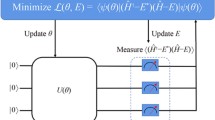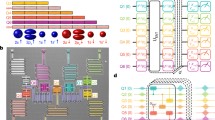Abstract
Several techniques for extracting excited states from the Hamiltonian operator have been studied in recent years. This analysis is essential in areas such as Molecular Chemistry and other branches of Quantum Physics, especially those related to optical spectra and chemical reaction processes. Moreover, the knowledge of the operators’ spectrum is required in other fields outside the Physics domains, since there are problems related to graph connectivity and principal component analysis which require a knowledge of, if not all, some important values of the operator spectrum. For those cases, part of the results clarifies that the eigenstate deflation can be used as a tool to extract the excited states. In consonance with these properties, we present a framework to perform the spectral decomposition for any dimension operator in a procedure based on the Householder reflections and unconstrained optimization using a meta-heuristic technique named Differential Evolution. The technique is discussed through examples and implemented in the superconducting real quantum device from IBM Quantum, whose results (without neglecting the system decoherence) follows the pattern expected for the respective models. We conclude our analysis, showing that the proposed framework presents encouraging results to exploit other scenarios in this field.











Similar content being viewed by others
Data availability
Data will be made available on reasonable request
References
Deutsch, D.: Quantum theory, the church-turing principle and the universal quantum computer. Proc. Royal Soc. Lond. 400, 97–117 (1985)
Sipser, M.: Introduction to the Theory of Computation. Cengage Learning, Boston (2007)
Deutsch, D., Jozsa, R.: Rapid solution of problems by quantum computation. Proc. Royal Soc. Lond. 439, 553–558 (1992)
Shor, P.: Polynomial-time algorithms for prime factorization and discrete logarithms on a quantum computer. SIAM J. Comput. 29, 1484–1509 (1997)
Ladd, T.D., Jelezko, F., Laflamme, R., Nakamura, Y., Monroe, C., O’Brien, J.L.: Quantum computers. Nature 464, 45–53 (2010)
Preskill, J.: Quantum computing in the NISQ era and beyond. Quantum 2(79), 1–20 (2018)
Peruzzo, A., McClean, J., Shadbolt, P., Yung, M.-H., Zhou, X.-Q., Love, P.J., Aspuru-Guzik, A., O’Brien, J.L.: A variational eigenvalue solver on a photonic quantum processor. Nat. Commun. 5, 4213 (2014)
Cerezo, M., Arrasmith, A., Babbush, R., Benjamin, S.C., Endo, S., Fujii, K., McClean, J.R., Mitarai, K., Yuan, X., Cincio, L., Coles, P.J.: Variational quantum algorithm. Nat. Rev. Phys. 3(1), 625–644 (2021)
Mermin, N.D.: Quantum Computer Science: An Introduction, 1st edn. Cambridge University Press, Cambridge (2007)
Kitaev, A.Y.: Quantum measurements and the abelian stabilizer problem. arXiv:quant-ph/9511026 20(1), 101–106 (1995)
Colless, J.I., Ramasesh, V.V., Dahlen, D., Blok, M.S., Kimchi-Schwartz, M.E., McClean, J.R., Carter, J., Jong, W.A., Siddiqi, I.: Computation of molecular spectra on a quantum processor with an error-resilient algorithm. Phys. Rev. X 8, 011021 (2018). https://doi.org/10.1103/PhysRevX.8.011021
Higgott, O., Wang, D., Brierley, S.: Variational quantum computation of excited states. Quantum 3, 156 (2019). https://doi.org/10.22331/q-2019-07-01-156
Jones, T., Endo, S., McArdle, S., Yuan, X., Benjamin, S.C.: Variational quantum algorithms for discovering Hamiltonian spectra. Phys. Rev. A 99, 062304 (2019). https://doi.org/10.1103/PhysRevA.99.062304
Nakanishi, K.M., Mitarai, K., Fujii, K.: Subspace-search variational quantum Eigensolver for excited states. Phys. Rev. Res. 1, 033062 (2019). https://doi.org/10.1103/PhysRevResearch.1.033062
Watkins, D.S.: Fundamentals of Matrix Computations. Wiley-Interscience, Hoboken (2002)
MacDonald, J.K.L.: Successive approximations by the Rayleigh-ritz variation method. Phys. Rev. 43, 830–833 (1933)
Koch, E.A.D.: Fundamentals in quantum algorithms: a tutorial series using qiskit continued (2020). arXiv:2008.10647
McClean, J.R., Boixo, S., Smelyanskiy, V.N., Babbush, R., Neven, H.: Barren plateaus in quantum neural network training landscapes. Nat. Commun. 9(4812), 1–6 (2018)
Bhatnagar, S., Prasad, H.L., Prashanth, L.A.: Stochastic Recursive Algorithms for Optimization: Simultaneous Perturbation Methods. Springer, Berlin (2013)
Hirokami, T., Maeda, Y., Tsukada, H.: Parameter estimation using simultaneous perturbation stochastic approximation. Electr. Eng. Jpn. 154(2), 30–3 (2006)
Storn, R.M., Price, K.: Differential evolution—a simple and efficient heuristic for global optimizationover continuous spaces. J. Glob. Optim. 11, 341–359 (1997)
Fiedler, P.M.: Algebraic connectivity of graphs. Czechoslov. Math. J. 23, 298–305 (1973)
Pothen, A., Simon, H.D., Liu, K.P.P.: Partitioning sparse matrices with eigenvectors of graphs. Report RNR-89-009—NASA Systems Division, 1–30 (1989)
Bishop, C.M.: Pattern Recognition and Machine Learning, 1st edn. Springer, Cambridge (2006)
Qiskit: 27. Quantum Chemistry II: finding the Ground States of H2 and LiH—Part 3 (2020). https://www.youtube.com/watch?v=o4BAOKbcd3o Accessed 01 September 2020
Kandala, A., Mezzacapo, A., Temme, K., Takita, M., Brink, M., Chow, J.M., Gambetta, J.M.: Hardware-efficient variational quantum Eigensolver for small molecules and quantum magnets. Nature 549(1), 242–246 (2017). https://doi.org/10.1038/nature23879
Buhrman, H., Cleve, R., Watrous, J., Wolf, R.: Quantum fingerprinting. Phys. Rev. Lett. 87, 167902 (2001). https://doi.org/10.1103/PhysRevLett.87.167902
Haferkamp, J., Faist, P., Kothakonda, N.B.T., Eisert, J., Yunger Halpern, N.: Linear growth of quantum circuit complexity. Nat. Phys. 18(5), 528–532 (2022)
Acknowledgements
We thank to IBM for access to superconducting quantum devices through the both Quantum Researchers Program and Qiskit SDK. Finally, we thank the Quantum Computing and Optimization group of the UNILA for the suggestions and discussions.
Author information
Authors and Affiliations
Contributions
All authors worked equally on the paper.
Corresponding author
Ethics declarations
Conflict of interest
The authors declare that the research was conducted in the absence of any commercial or financial relationships that could be construed as a potential conflict of interest.
Additional information
Publisher's Note
Springer Nature remains neutral with regard to jurisdictional claims in published maps and institutional affiliations.
Rights and permissions
Springer Nature or its licensor (e.g. a society or other partner) holds exclusive rights to this article under a publishing agreement with the author(s) or other rightsholder(s); author self-archiving of the accepted manuscript version of this article is solely governed by the terms of such publishing agreement and applicable law.
About this article
Cite this article
Albino, A.S., Bloot, R. & Gomes, R.F.I. Variable ansatz applied to spectral operator decomposition in a physical superconducting quantum device. Quantum Inf Process 22, 233 (2023). https://doi.org/10.1007/s11128-023-04001-5
Received:
Accepted:
Published:
DOI: https://doi.org/10.1007/s11128-023-04001-5




